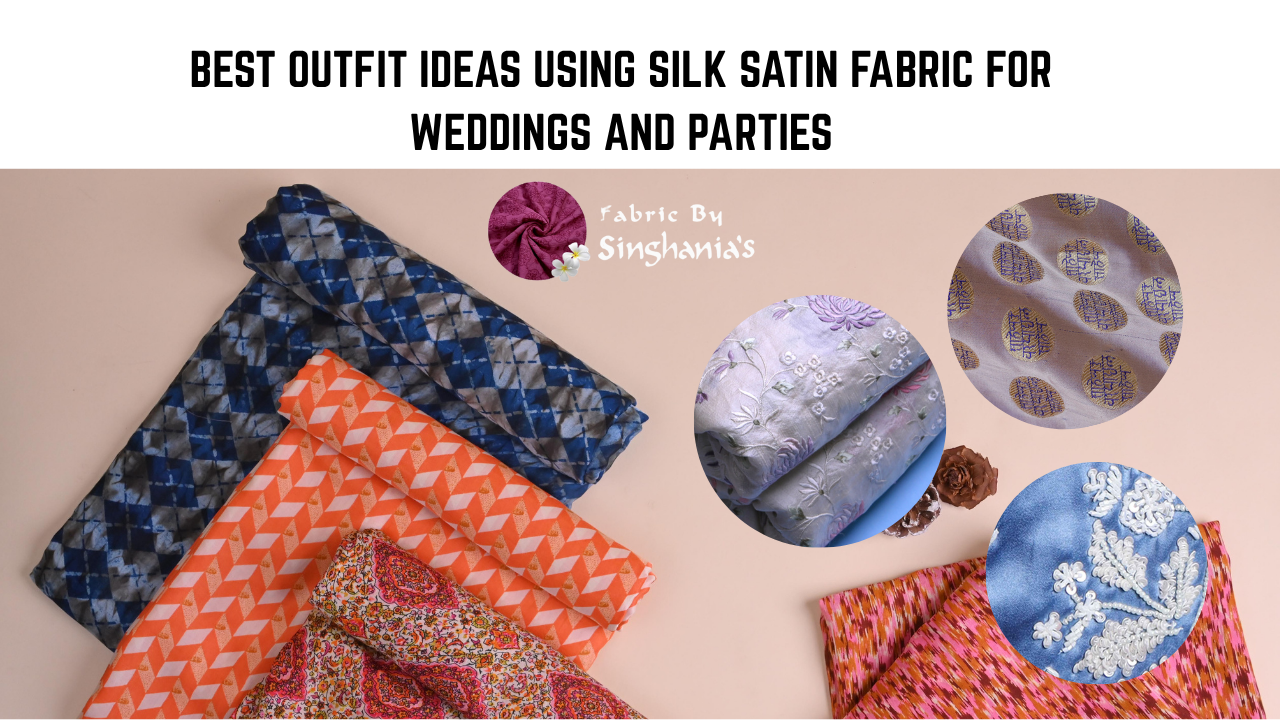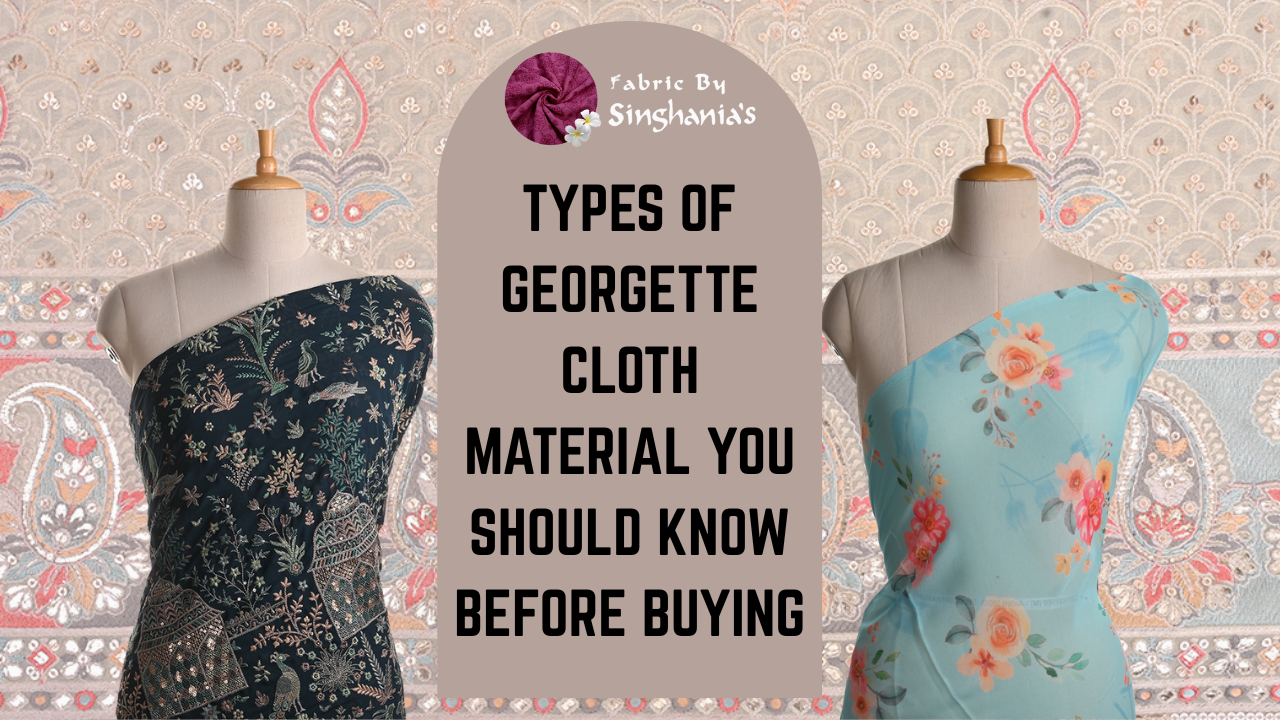Some choices are quiet. They do not ask for attention, but they stay with us like an old saree you have seen your mother wear for years or the way a dupatta rests on your shoulder before a family gathering. You might first notice the embroidery or the colours, but underneath it all, holding everything in place, is the embroidery fabric material.
Embroidery is more than decoration. It is heritage passed from hand to hand, needle to needle. And that delicate artistry rests on one thing: the right embroidery fabric material.
At Fabrics By Singhania's, we have always honoured the older way of choosing slowly, with care, with respect for the weaver, and for the story each thread tells. Because fabric material is never just a base. It is the first part of memory-making.
Why Choosing the Right Embroidery Fabric Matters
You may notice the embroidery first, but its true beauty shows in how it sits on the embroidery fabric material online, how it moves with you, and how well it stays with time. The base embroidery fabric material is not just a support it is a co-creator of beauty.
It carries the weight of the craft
Some embroidery fabric material doesn’t call for attention, yet it stays with you quietly memorable and deeply felt. Others resist, distorting delicate work. A good base invites the embroidery in, like a warm home welcomes its guests.
It shapes how your garment falls
A soft net flows like water but cannot hold too much embellishment. A heavier raw silk provides structure, perfect for garments that need volume. The embroidery fabric material must always suit the purpose.
It defines comfort
Even a beautiful kurta or saree won’t feel right if the embroidery fabric is too rough or heavy. If it’s not comfortable on the skin, it’s hard to truly enjoy wearing it especially with how our weather shifts across India.

The embroidery fabric also decides how well your outfit holds up over time.
Embroidery often adds weight, and time tests strength. The right embroidery fabric material will hold its stitches not for a season, but for years ready to be worn again, or passed down with pride.
It dictates how to care for it
Some fabric material like pure silk or velvet ask for delicate handling. Others, like cotton-silk or chanderi, are more forgiving. Knowing what the fabric needs helps you care for your outfit as it deserves.
A chikankari piece calls for soft, sheer embroidery fabric. Zardozi demands something sturdier. Each art form has a preferred canvas, and honouring that match enhances both beauty and integrity.
Best Types of Embroidery Fabric for Different Styles
No two outfits are quite alike. And just as every person has a personality, so too does each embroidery fabric material. Let us look at how different materials lend themselves to different types of garments and embroidery styles.
-
Sarees and Dupattas Meant to Float
For these pieces, the embroidery fabric must hold embroidery lightly never too stiff, never too heavy.
Ideal Choices: Organza, Tissue, Silk Georgette, Fine Net
Light and graceful, these embroidery fabric materials carry delicate embroidery well. A tissue saree or an organza dupatta with soft threadwork adds quiet charm without effort.
-
Lehengas That Carry Tradition Gently
A bridal lehenga is not just about how it looks it’s about how it holds. It needs to feel secure, carry the embroidery with ease, and stay graceful from the first ritual to the last photograph.
Rich and sturdy, these embroidery fabric materials are perfect for heavy embroidery. They bring shape and elegance to bridal lehengas and festive wear.
3. Kurtas and Festive Wear
Not every outfit needs to shine. Sometimes, it’s the ones you wear often that matter more.
Ideal Choices: Chanderi, Cotton-Silk, Modal, Muslin
These embroidery fabric materials are gentle and comfortable against the skin. A small amount of basic stitching is all they require. They’re suitable for everyday use or small events.
4. Blouses and Tunics That Frame You Just Right: Some parts of an outfit are meant to catch the eye.
Ideal Choices: Raw Silk, Brocade, Embroidered Net, Satin
These embroidery fabric materials hold bold embroidery beautifully. A detailed blouse or tunic in these materials can lift even the simplest outfit.
5. For the Modern Twist
When tradition meets today’s taste, the result is something beautifully balanced.
These embroidery fabric materials go well with modern looks soft colours, simple designs, and neat stitches.
Common Mistakes to Avoid with Embroidery Fabric
Even a seasoned buyer can slip. Here are the most common oversights:
Choosing Fabric by Colour Alone
A rich shade might charm the eye, but if the fabric material is too loose or too tight in weave, the embroidery won’t hold well. Let your hands decide as much as your eyes.
Forgetting the Role of Lining
Sheer embroidery fabric like net or tissue usually need a lining not just for coverage, but to help the embroidery stand out.
Disregarding Season and Occasion
Wearing velvet in the peak of summer may win compliments, but the discomfort won’t be forgotten. Always weigh the feel of the fabric material against the setting.
Blindly Following Trends
Fads come and go. Let comfort, your body type, and tradition guide your choice. The right embroidery fabric always looks right when it feels right.
Matching Embroidery Fabric with Outfit Types
Picking the right embroidery fabric is a bit like picking the right words for a poem.
-
Sarees need fabric material that’s light but strong enough to hold the embroidery well.
-
Velvet, dupioni, and raw silk are sturdy and rich. They carry heavy embroidery without losing shape.
-
Chanderi, cotton-silk, and muslin are light and kind on the skin.
Brocade, raw silk, or net with light embroidery can gently brighten up any outfit.
Final Checklist for Picking the Right Embroidery Fabric
Embroidery fabric isn't about trends. It's about touch, comfort, and the moment.
-
On hot days, cotton-silk or organza keeps things light.
-
When it’s colder, raw silk or velvet keep you warm and hold shape.
-
If the embroidery is heavy, the embroidery fabric material should be strong.
-
Some materials, like tissue or organza, are a bit see-through. A lining helps.
Comfort matters too.
Also think about how to care for the embroidery fabric. Fabric isn’t about fashion. It’s about how it feels.
Where to Buy Quality Embroidery Fabric
Not every embroidery fabric is created the same. And when it comes to embroidery, that difference shows in how the thread settles, how the weave endures.At Fabrics By Singhania's, we believe embroidery fabric material should do more than decorate it should honour tradition.
Our embroidery fabric online collection comes from weavers across India who know the craft.
We don’t just look at how it shines. We see how it sits on the skin, how it carries the embroidery, how it lasts.
You can buy high-quality embroidery fabric online at Fabrics By Singhania's each one thoughtfully selected.
If you’re looking for fabric material online that’s full of meaning, you’ll find it with us.








